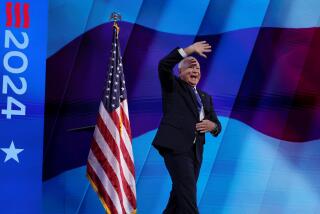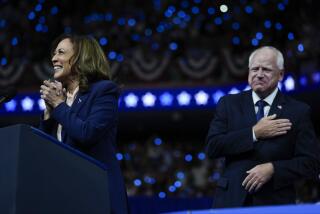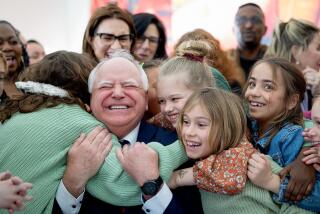How Clinton Narrowed His List to Just One
- Share via
It began in a Florida hotel room on April 23, when Arkansas Gov. Bill Clinton huddled with two close advisers and brainstormed for several hours about men and women who could join his ticket as vice president.
When the session ended, Clinton, campaign chairman Mickey Kantor and Los Angeles attorney Warren Christopher--whom Clinton had tapped to head his vice presidential search committee--had a list of about 40 possibilities, including governors, senators, mayors and people from outside politics. Thus began a methodical and intensely secretive process that ended 76 days later in the selection of Tennessee Sen. Albert Gore Jr. at a late-night meeting in the governor’s mansion in Little Rock, Ark., on Wednesday.
In choosing Gore over about half a dozen other finalists, Clinton rejected the traditional political calculus of balancing the ticket and instead selected a running mate who reinforced his basic geographic, ideological and generational appeal. “We’re in a new era,” Kantor said in an interview. “We have post-World War II problems, and we need post-World War II leadership. People are looking for change, and this ticket certainly represents that.”
Gore emerged from a search that reflected the classic Clinton pattern of operation: He consulted widely and held the final decision closely.
Clinton laid out his broad priorities for the search to Kantor and Christopher on April 10, just three days after his decisive victory in the New York primary. Clinton told the two men that he wanted a running mate who shared his values, offered complementary strengths and could serve as President immediately. Clinton insisted that traditional political calculations of balancing the ticket--particularly in geographic terms--were less important to him, Christopher said Thursday.
Once Clinton, Christopher and Kantor produced their initial list of 40 possibilities in late April, the vetting process began. The search committee headed by Christopher included former Vermont Gov. Madeleine M. Kunin and civil rights leader Vernon E. Jordan Jr., as well as a staff of seven young attorneys and researchers to review the possibilities.
Using newspaper clippings and other public documents, those researchers produced five- to 15-page memos on the potential candidates, focusing on their records and views on public policy.
At the same time, Clinton continued to cast a wide net for advice. Christopher said he consulted with 50 people around the country looking for names. Clinton himself pursued suggestions in wide-ranging sessions with friends and advisers.
Among the ideas discussed in these sessions was finding a businessman who could blunt some of Ross Perot’s independent appeal; John Sculley, chairman and chief executive officer of Apple Computer Inc., was one name raised in conversation. “But there was no obvious businessman who could fit the bill,” said one source who participated in discussions with Clinton.
At another informal meeting, said the source, Clinton asked: “Who are the leading citizens in the country?” He answered his own question by naming Marian Wright Edelman, head of the Children’s Defense Fund. Clinton’s wife, Hillary, has served on the group’s board and is close to Edelman, but it became clear that Edelman did not want to be considered for the vice presidency, the source said.
Other, more conventional, names that floated through Clinton circles during this period included Texas Gov. Ann Richards, California State Treasurer Kathleen Brown, former Massachusetts senator and presidential candidate Paul E. Tsongas, Baltimore Mayor Kurt Schmoke, Georgia Rep. John Lewis and Rep. Nancy Pelosi (D-San Francisco), the source said.
But apparently none of them was still on the list on June 8, when Clinton narrowed down the possibilities to what Kantor called “six or seven” finalists.
All the finalists submitted financial and medical records. A new team headed by Washington attorney Richard Moe, a former top aide to Walter F. Mondale, reviewed these records through June. (Financial records were not solicited from either New York Gov. Mario M. Cuomo or New Jersey Sen. Bill Bradley, both of whom had repeatedly indicated their disinterest in the job, Kantor said.)
Campaign aides refused Thursday to identify the finalists, but the interviews with potential running mates that Clinton conducted during the past few days effectively sketched out the list. Those who met with Clinton included Gore, who held a long meeting with the presumptive nominee at the Capital Hilton hotel in Washington on June 30; Indiana Rep. Lee H. Hamilton, and Sens. Bob Graham of Florida, Harris Wofford of Pennsylvania and Bob Kerrey of Nebraska.
Gore appeared to emerge as a clear favorite in the Clinton camp over the past week--particularly after Hamilton suffered through a stormy appearance on NBC’s “Meet the Press” Sunday. In that interview, Hamilton praised the recent Supreme Court decision on Pennsylvania’s restrictive abortion law, which Clinton had condemned. He also reiterated his opposition to the parental leave law Clinton has endorsed--a point the Arkansas governor raised in subsequent conversations.
In the end, Clinton and his confidantes saw several advantages in selecting Gore. Among the key factors, said Kantor, were Clinton’s belief that Gore could step in and serve as President; the fact that the senator had been tested in a national campaign during his own 1988 presidential bid; Clinton’s conclusion that they were compatible on the issues; and the sense that Gore was physically capable of conducting an energetic campaign.
Reinforcing those factors was the unique political geography of 1992. With two Southerners on their ticket, Clinton aides hope to attract enough white votes, along with the Democratic black base in the South, to recapture states that have long been controlled by the GOP in presidential elections. That goal becomes plausible, they believe, because Perot is likely to draw most of his votes from whites, thus splitting the GOP base in the region.
Other insiders said that Gore offered strength in areas where Clinton may be vulnerable, such as the environment; likewise Gore served in the Vietnam War that Clinton avoided.
It’s not known exactly which, if any, of these considerations were foremost in Clinton’s mind Wednesday night as he led Christopher, aides Bruce Lindsey and Mark Gearan and his wife, Hillary, through a two-hour discussion of the half a dozen remaining candidates in the executive mansion’s east conference room; Kantor checked in by phone. All the names remained on the table as the conversation began, sources said.
But shortly after 11 o’clock, Clinton asked Lindsey for Gore’s phone number, and the 45-year-old prospective nominee called the 44-year-old senator to offer him the chance to create the first all-baby boomer presidential ticket.
Times political writer Cathleen Decker contributed to this account.
More to Read
Get the L.A. Times Politics newsletter
Deeply reported insights into legislation, politics and policy from Sacramento, Washington and beyond. In your inbox twice per week.
You may occasionally receive promotional content from the Los Angeles Times.











